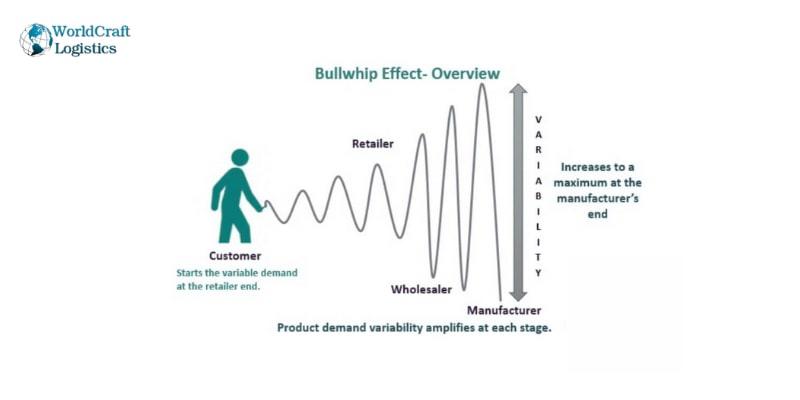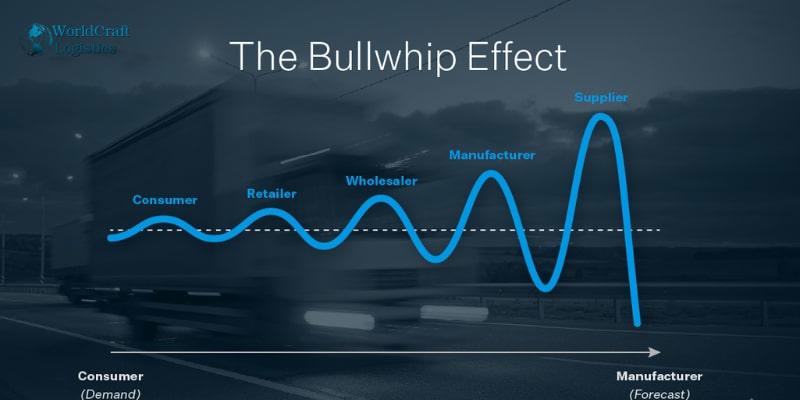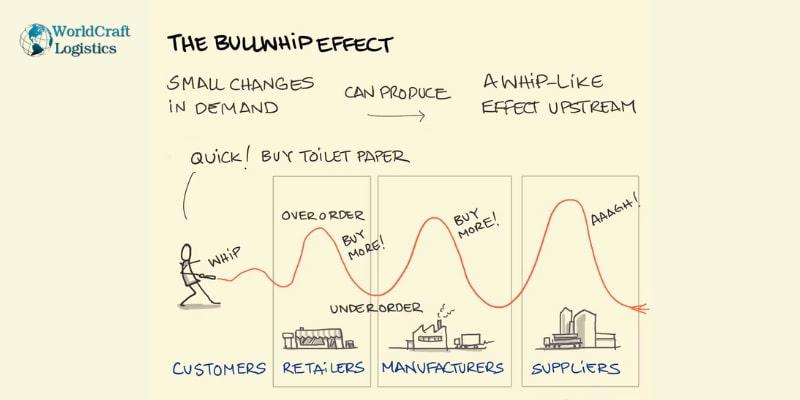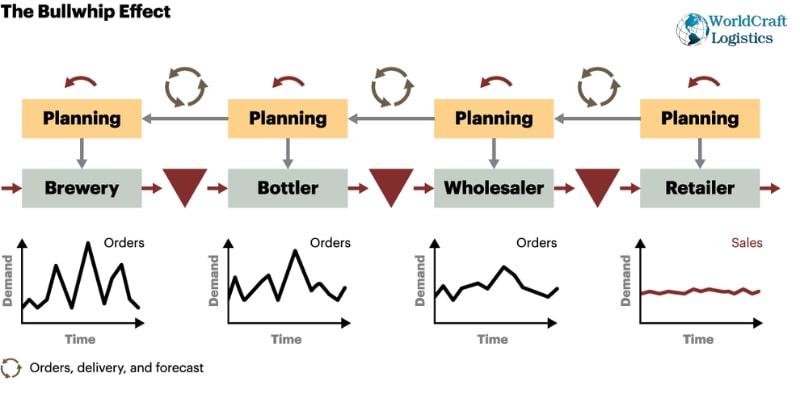
Starting June 1st, 2023 Our warehouse fee will be $0.65/cubic foot per month
In effort to lower the warehouse storage fee during inflation, we have went narrow aisle racking.This construction took us four months but the project is finally completed. With narrow aisle racking, we are able to drop storage by 24%.We as partners will go through this inflation together.
10/06/2023
A supply chain phenomena known as the bullwhip effect explains how modest changes in demand at the retail level can lead to steadily bigger changes at the wholesale, distributor, manufacturer, and raw material supplier levels. The physics of a whip crack inspired the name of the effect. The very slight movement of the person holding the whip snapping their wrist causes the wave patterns to progressively get louder.
In supply chain management, only a portion of the supply chain is directly under the direct control of consumers, suppliers, manufacturers, and salespeople. However, everyone has an impact on the entire chain due to their inaccurate forecasts (buying too much or too little). Any alteration along the supply chain might have a significant impact on the other links. Given this, the bullwhip effect in supply chain management has a wide range of contributors and causes.

The bullwhip effect has a large impact on supply chain management and has the following effects:
Storage costs: The cost of overstock isn’t cheap. You must pay for the physical storage space, as well as the inefficiency of storing items that may not be in high demand anymore, and the cost of transporting and selling the items, which could be steep if you have to discount the products to get people to buy them. The bullwhip effect also makes your storage and shipping costs less predictable.
Increased labor: To handle, organize, and sell additional products that you have on hand, you must pay personnel. Similar to this, salespeople may need to put in more effort to find alternatives or schedule later delivery if a seller runs out of goods. These labor needs may accumulate.
Unmet customer expectations: Your reputation and revenue may suffer if you run out of a product. Being unable to offer products might annoy your clients, make you appear less dependable, and even prompt some of them to search for new partners or brands. This is true whether you're trying to satisfy the demands of consumers or other supply chain participants.
Waste: Depending on the product you work with, having too much inventory can result in expensive waste. Consumable commodities like meals and medicines, for example, could expire before you can sell off your supply, while other products might be taken off the market or replaced by newer models. These occurrences may decrease the worth of the objects, increase the amount of resources needed to sell them, or increase the cost of an item that needs to be purchased for you.

Consider a store selling hot chocolate that, throughout the winter, routinely sells 100 cups each day. That store sells 120 cups instead on an especially frigid day there. The shop asks the distributor for ingredients for 150 cups, mistaking the sudden uptick in sales for a wider trend. The distributor notices the rise and increases its purchase order with the manufacturer to account for rising demand from more stores. In preparation for future increases in product demand, the manufacturer extends its manufacturing run.
Demand projections have become more and more distorted at each point above. When the weather gets back to normal and hot chocolate sales pick up, the business might find that it has more supplies than it needs. The manufacturer and distributor will have even more extra stock.
Another reason for the absence of information is that larger logistics operations at the wholesale level take longer to alter, which means that by the time a wholesaler has responded, the circumstances that led to a shift in demand at the retail level may have passed. The challenge of accurately responding to changes in demand increases as modifying manufacturing output takes longer still and information from retailers arrives at producers with even greater lag.
The bullwhip effect in supply chain can happen even if the store correctly predicted demand, for instance because a nearby hot chocolate festival had just begun. The distributor might presume this is due to an increase in the demand for hot chocolate generally rather than specific circumstances for that retailer because they are not completely aware of the local circumstances. The producer would be much less likely to comprehend and appropriately respond to the shift in demand because of their further distance from the situation.

Companies must estimate customer demand based on incomplete data and attempt to foresee the quantity of product that customers will truly need while taking into account the complicated aspects that enable that quantity to be delivered accurately and on schedule. Every step of the supply chain has the potential for changes and disruptions, which have an impact on the numerous supplier orders. All the other elements in the chain, including inventories, are directly impacted by changes in client demand. But even in reasonably stable markets where demand is virtually consistent, the bullwhip effect can happen.

Demand forecasting has never been an easy task. This challenge is made more difficult by the expanding complexity of today's global supply chains as well as by consumers' growing desire for omnichannel and e-commerce. The following are a handful of the most frequent dependencies that might result in a bullwhip effect:
Difficulties with lead times, such production delays.
Poor choices made by supply chain participants at any stage of the chain, for as in shipping or customer service.
A lack of coordination and communication throughout the supply chain's various stakeholder organizations.
Over- or under-reacting to demand expectations, such as ordering too many units or not enough.
Companies, often retailers waiting until orders build up before placing orders with their suppliers, a practice called order batching.
Discounts, cost changes and other price variations that disrupt regular buying patterns, and inaccurate forecasts from over-reliance on historical demand to predict future demand.
The bullwhip effect can be reduced to a minimum to guarantee more predictable and successful supply chain management. The bullwhip effect supply chain can be caused by a variety of factors, but it can also be fixed in a number of ways. Listed below are some suggestions for minimizing the bullwhip effect.

Because supply chain participants don't fully understand the reasons why consumers are raising demand, the bullwhip effect intensifies. Everyone may better understand the context of demand shifts by increasing visibility throughout the chain. Are more orders being placed as a result of a discount, seasonal demand, or another factor? Members can identify potential overreaction triggers and address them before the situation spirals out of control.
Here are several instruments that are useful:
Electronic Data Interchange (EDI): With the use of EDI, business partners such as suppliers, clients, carriers, and third-party logistics (3PL) providers can exchange documents in real time. Ordering, providing shipment notifications, and invoicing are just a few of the many functions that EDI systems may automate and optimize. They substitute for and standardize a number of manual procedures like snail mail, email, and fax. Consequently, EDI can hasten communication, boost visibility, and strengthen partnerships.
Vendor Managed Inventory (VMI): Suppliers can get real-time sales and forecast information from their downstream partners thanks to VMI initiatives. The data is evaluated by a machine-learning algorithm along with predetermined settings like min/max shelf presence to produce replenishment recommendations. Suppliers can place new orders without waiting for retailers or distributors to run out or run low using VMI. Instead, to reduce both stockouts and overstocking, they can schedule a new supply to arrive at the appropriate moment.
Internet of Things (IoT): A rapidly expanding field of supply chain management is IoT. Real-time data regarding stock counts and product locations can be obtained through sensors that are connected to your system. Greater openness on the part of the organization may also mean greater openness among supply chain partners. Other predictive advantages include the ability to foresee problems and upkeep requirements that can impair operations or product quality.
Supplier Enablement portals: Supplier enablement portals allow suppliers and buyers to interact effectively and uniformly even without EDI. Both those who use and those who do not utilize EDI solutions can easily integrate with each other's systems thanks to portals' support for web EDI interfaces and EDI solutions.
To understand demand shifts better, projections must be made with care. You can gather information on almost every aspect of your company's operations and transform that information into insightful recommendations for preventing the bullwhip effects using the large variety of intelligent inventory software currently available.
Advanced algorithms and calculations are used in predictive analytics to analyze historical trends, present-day events, and estimate future trends. These systems might be basic or complicated, many of them utilizing artificial intelligence (AI), but they all depend on reliable data.
Demand forecasting can be challenging, but by incorporating additional data, predictive analytics can make it better. You can use predictive tools to choose the best delivery options and inventory levels. Inventory management can be greatly enhanced by integrating predictive techniques like VMI with IoT devices, other data-collection tools, and EDI. A large portion of the industry is already on board; according to Gartner, by 2024, more than 50% of supply chain firms will invest in apps using AI and advanced analytics.

To prevent experiencing the bullwhip effect, various supply chain participants must cooperate. Sharing information is crucial in this situation because it enables organizations to work together and see the entire supply chain rather than just the portion they control. Collaboration is crucial in supply chains that are becoming more globally interconnected, as goods may travel across borders and pass through numerous companies.
End-to-end visibility and real-time data are crucial. For instance, sending purchase orders is very different from strategic collaboration, when you and your partners cooperate to increase forecast accuracy, fortify ties, and avert problems before they happen. Keeping everyone on the same page can be accomplished by aligning your key performance indicators (KPIs) and other performance measures. VMI is the cornerstone of this strategy since it centralizes the data needed for collaboration and uses EDI to push and pull inventory and order data across partners.
One of the best barriers to the bullwhip effect, which typically results from disjointed inventory methods, is robust teamwork.
Long lead times can make the bullwhip effect worse by causing things to arrive far later than they are required and turn into overstock. Bullwhip problems can be reduced by shortening lead times everywhere and scheduling orders when demand is high.
Depending on your company's needs, the factors affecting lead times will change, however some techniques to cut lead times include:
Using reliable, regional vendors: Getting the product closer to its destination can cut lead times and expenses. Finding trustworthy, quick partners is always possible, even though this option isn't always a good choice.
Investing in VMI: Real-time data can be used to accelerate restocking instead of waiting for new orders, greatly reducing or perhaps completely eliminating the amount of time shelves are empty.
Recruitment of a logistics manager: You can increase the level of monitoring and focus on inventory management with a team member devoted to logistics. They should ideally shorten your lead times and assist with other aspects of the bullwhip effect.
Reevaluating your shipping methods: Check your shipping alternatives if lengthy lead times or unpredictable deliveries are a concern for you. See whether this choice would be feasible for you if one of your partners offers air shipping but prefers to ship internationally via boat. Benefits of more predictable inventories may outweigh additional expenditures.
Automating manufacturing: On the manufacturing side, you could be able to provide shorter lead times if you have automated machinery and software that makes the process more effective.
Lead times should be precise and brief: Even if you are unable to significantly shorten your lead times, doing it appropriately can assist assure better order fulfillment and less unhappy customers.
If you routinely provide discounts or promotions, you might be upsetting customary buying patterns and making it harder to forecast demand. Consider your position on these promotions and whether there may be more disruptions than benefits. It's possible that you don't need to completely eliminate them, but you should think about reducing them or accurately factoring them into your projections and predictions.
The bullwhip effect can swiftly spiral out of control and have a negative impact on every link in the supply chain. The best tools you have to combat the bullwhip effect are visibility and transparency, and the correct platforms can assist you in finding both. You can lessen the bullwhip impact whether you're a seller, supplier, 3PL, or another link in the supply chain.
By leveraging appropriate communication channels, sharing real-time consumer demand data, raising awareness of the actual wants at each stage, and utilizing artificial intelligence to predict precise demands in supply chain management, the bullwhip effect can be avoided.
The bullwhip effect can get reduced using proper communication channels, sharing real-time customer demand data, creating awareness of the actual demands at every point, and deploying artificial intelligence to predict exact demands in supply chain management.
The lead time issues, the least optimum decisions made at every link in the supply chain, the adoption of order batching of items, incorrect demand estimates for goods, and the implementation of sales promotions are the main causes of the bullwhip effect.

In this article, Worldcraft Logistics explains to readers what the bullwhip effect? It also provides detailed information about the impacts, for example, instructions on how to avoid the bullwhip effect in the supply chain. Follow our next articles to learn important knowledge. Thanks for watching.
SEO
Digital Marketing/SEO Specialist
Simon Mang is an SEO and Digital Marketing expert at Wordcraft Logistics. With many years of experience in the field of digital marketing, he has shaped and built strategies to effectively promote Wordcraft Logistics' online presence. With a deep understanding of the logistics industry, I have shared more than 500 specialized articles on many different topics.

Education
01/05/2025

Education
02/18/2025

Education
01/01/2024

Education
08/28/2024

Education
11/13/2023